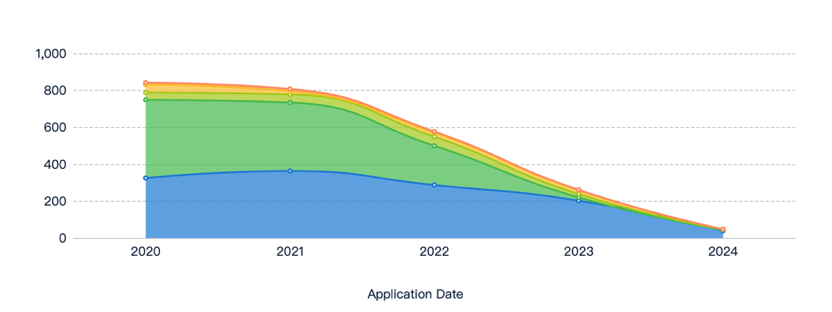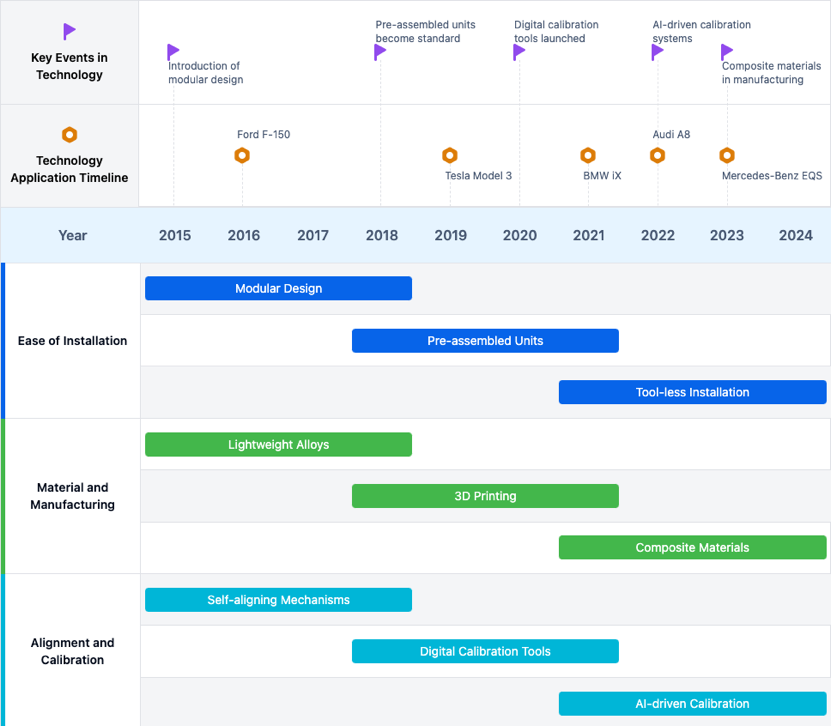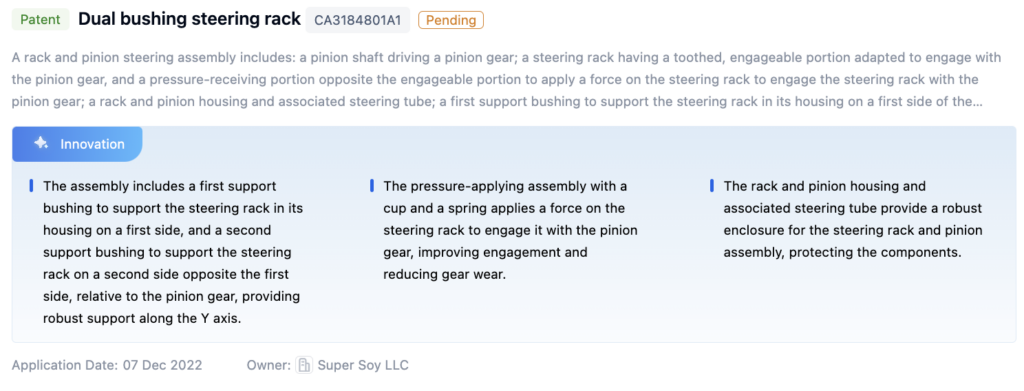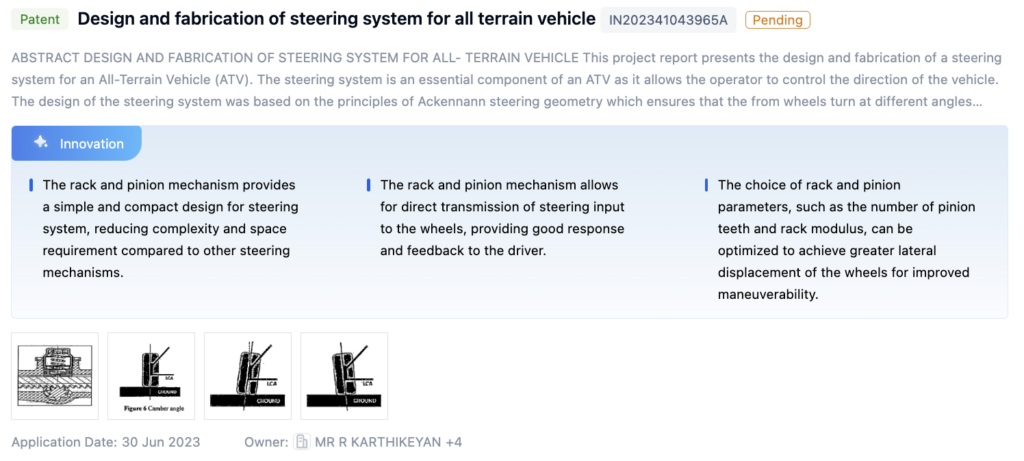
Technical Background and Objectives
The rack and pinion steering system is a crucial component in modern vehicles, converting the rotational motion of the steering wheel into the linear motion required to turn the wheels. While widely adopted for its simplicity and efficiency, the installation process can be complex and time-consuming, often requiring specialized tools and expertise. This can lead to increased labor costs and potential errors, compromising performance and safety.
This research aims to explore innovative solutions to simplify the installation process, making it more efficient, cost-effective, and accessible. The goal is to improve user experience, reduce maintenance costs, and enhance the reliability and longevity of these steering systems. Streamlining the installation process can also boost productivity in automotive manufacturing and repair facilities, benefiting both manufacturers and consumers.

To get detailed scientific explanations of rack and pinion steering, try Patsnap Eureka TechResearch.
Market Demand Analysis
The demand for rack and pinion steering systems is driven primarily by the automotive industry, where these systems are widely used in passenger vehicles, light trucks, and commercial vehicles. Ease of installation is a crucial factor influencing adoption among manufacturers and aftermarket service providers.
Automakers seek efficient, cost-effective assembly processes, with systems that can be quickly installed to improve productivity and reduce costs. The trend toward modular vehicle designs has further increased the demand for easily integrable steering systems. In the aftermarket, quick installation reduces labor costs and speeds up service times.
Additionally, vehicle electrification and autonomous driving technologies create new opportunities for advanced rack and pinion steering systems. These systems need to be designed for easy integration with other vehicle components, such as sensors and control modules.
Current State and Challenges

Installing rack and pinion steering systems is traditionally complex, requiring precise alignment and specialized tools. This increases labor costs, extends assembly times, and can lead to quality issues if not done correctly.
Challenges include the intricate design of the system, limited space in modern vehicles, and the integration of advanced driver assistance systems (ADAS), which add layers of complexity. Geographic factors, such as access to specialized tools and training, can also impact installation quality and costs.
Despite these challenges, manufacturers are working on solutions to improve installation ease. These include redesigning components for better accessibility, developing modular assemblies for easier pre-assembly, and using advanced manufacturing techniques to reduce the need for adjustments during installation.
Technology Evolution Path

Current Technical Solutions For Easier Rack and Pinion Steering Installation
Rack and Pinion Steering System Design
Designs focus on improving performance, durability, and ease of installation through modular components, pre-assembled subassemblies, and optimized materials. Enhancements include better steering feel, compact and lightweight designs, and reduced noise and vibration.
Rack and Pinion Steering Gear
Key improvements target efficiency, reduced friction, and enhanced responsiveness. Innovations include power assist mechanisms, variable ratios for better control, and simplified installation methods.
Power-Assisted Rack and Pinion Steering
These systems incorporate hydraulic or electric assistance to reduce steering effort, especially in larger vehicles. Designs focus on compactness, easy installation, and improved durability for extended service life.
Rack and Pinion Steering Assembly and Installation
Innovations in assembly design emphasize easy installation, maintenance, and optimized performance. Solutions include modular construction, quick-release mechanisms, and designs tailored to specific vehicle types.
Rack and Pinion Steering Components
Component designs, such as rack bars, pinion gears, and housings, are optimized for durability, ease of maintenance, and improved steering feel. Compact, lightweight options are available, along with integrated power assistance to enhance steering comfort.
Key Players Analysis
The competitive landscape for improving the ease of installation in rack and pinion steering systems is shaped by industry growth, market size, and technology maturity. Companies like Hyundai Mobis Co. Ltd., Robert Bosch GmbH, and ThyssenKrupp Presta AG lead the way with advanced solutions, while Steering Solutions IP Holding Corp. and Schaeffler Technologies AG & Co. KG are also making significant strides in innovation and implementation.
- Hyundai Mobis Co. Ltd.: Developed a modular rack and pinion steering system that simplifies installation by integrating key components into a single unit, reducing parts and assembly steps.
- Robert Bosch GmbH: Offers an advanced electric power steering system with pre-aligned components and plug-and-play electrical connections, significantly reducing installation time and complexity.
- ThyssenKrupp Presta AG: Developed a lightweight steering system designed for ease of installation, using high-strength materials and a modular design that allows quick assembly.
- Steering Solutions IP Holding Corp.: Offers a customizable system with pre-configured mounting points and alignment features, streamlining the installation process.
- Schaeffler Technologies AG & Co. KG: Provides a high-precision system with pre-lubricated components and self-aligning features, reducing the need for adjustments during installation.
Key Technology Insights
Patent 1: Dual Bushing Steering Rack
- Key Points:
- Robust support with dual bushings on opposite sides of the pinion gear.
- Pressure-applying assembly improves gear engagement and reduces wear.
- The housing provides a robust enclosure, protecting the assembly.

Patent 2: Design and Fabrication of Steering System for All-Terrain Vehicle
- Key Points:
- Compact design reduces complexity and space requirements.
- Direct transmission of steering input offers good response and feedback.
- Optimized rack and pinion parameters improve maneuverability.

Potential Innovation Directions
- Improved Installation Process: Features like modular components, pre-assembled subassemblies, or simplified mounting mechanisms can reduce installation complexity and time.
- Compact and Lightweight Design: The system is engineered to be compact and lightweight, making it easier to handle and install, especially in confined spaces.
- Modular and Adjustable Components: The system includes modular and adjustable components, allowing customization and fine-tuning during installation to accommodate different vehicle configurations.
- Integrated Installation Aids: Installation aids such as alignment guides, positioning markers, or pre-installed fasteners are integrated into the system to simplify and streamline the installation process.
Regulatory and Compliance Considerations
Regulatory and compliance considerations are crucial in developing and implementing rack and pinion steering systems. These systems must meet stringent safety and performance standards set by various regulatory bodies. Compliance with frameworks like the Federal Motor Vehicle Safety Standards (FMVSS) and ISO standards is essential. Environmental regulations, such as the European Union’s RoHS directive, and industry guidelines from organizations like SAE and AIAG, must also be adhered to. Failure to comply with these regulations can result in recalls, fines, and legal liabilities, making robust compliance programs and thorough testing vital for manufacturers.
Installation Ease Optimization Strategies
Optimizing the ease of installation for rack and pinion steering systems is crucial for enhancing user experience and reducing maintenance costs. Strategies include:
- Modularization of Components: Breaking down the installation into manageable steps with modular components.
- Advanced Manufacturing Techniques: Using 3D printing, CAD, and VR simulations for customized components and training.
- Intelligent Sensors and Feedback Systems: Monitoring critical parameters during installation to ensure optimal performance.
- User-Friendly Guides and Tools: Providing clear instructions and specialized tools to streamline the process.
- Cloud-Based Platforms and Remote Assistance: Offering real-time support and troubleshooting capabilities.
If you want in-depth research or a technical report, you can always get what you want in Patsnap Eureka TechResearch. Try now!

